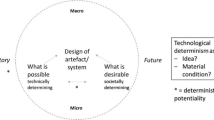Abstract
In general, designing is conceived as a complex, personal, creative and open-ended skill. Performing a well-developed skill is mainly an implicit activity. In teaching, however, it is essential to make explicit. Learning a complex skill like designing is a matter of doing and becoming aware how to do it. For teachers and students therefore, it will be helpful to make the design process explicit. In this paper, a conceptual framework is developed to be more explicit about the design process. Based on research of the design process, on differences between novices and expert designers, and on personal experience in design education practice, five generic elements in the design process are distinguished: (1) experimenting or exploring and deciding, (2) guiding theme or qualities, (3) domains, (4) frame of reference or library, (5) laboratory or (visual) language. These elements are generic in the sense that they are main aspects and always present in the complex, personal, creative and open-ended design process.







Similar content being viewed by others
Notes
Developed and given by Elise van Dooren and Luc Willekens, TU Delft.
Personal communication.
References
Anderson, M. L. (2003). Embodied cognition: A field guide. Artificial Intelligence, 149, 91–130.
Atman, C. J., & Turns, J. (2001). Studying engineering design learning: Four verbal protocol studies. In C. Eastman, M. Newstetter, & M. McCracken (Eds.), Design knowing and learning: Cognition in design education (pp. 37–60). Oxford: Elsevier Science.
Bielefeld, B., & El Khouli, S. (2007). Design ideas. Basel: Birkhauser Verlag AG.
Boden, M. (1990). The creative mind: Myths and mechanisms. London UK: Weidenfeld and Nicholson.
Cross, N. (2001). Design cognition; Results from protocol and other empirical studies on design activity. In C. Eastman, M. Newstetter, & M. McCracken (Eds.), Design knowing and learning: Cognition in design education (pp. 79–104). Oxford: Elsevier Science.
Cross, N. G. (2007). Designerly ways of knowing. Basel, Boston, Berlin: Birkhauser.
Csikszentmihalyi, M. (1996). Creativity, flow and the psychology of discovery and invention. New York: HarperCollins Publishers.
Darke, J. (1979). The primary generator and the design process. Design Studies, 1(1), 36–44.
Dreyfus, H. L., & Dreyfus, S. E. (1986). Mind over machine, the power of human intuition and expertise in the era of the computer. New York: Free Press.
Eastman, C., Newstetter, M., & McCracken, M. (Eds.). (2001). Design knowing and learning: Cognition in design education. Oxford UK: Elsevier Science.
Goldhoorn, B. (1991). Het atelier, analyse van een onderwijsmethode. Archis, 3, 49–51.
Keysers, C. (2012). Het empathische brein. Amsterdam: uitgeverij Bert Bakker.
Kolb, D. A. (1984). Experiental learning: Experience as the Source of learning and development. New Jersey: Prentice Hall.
Lawson, B. (1994). Design in mind. Oxford: Architectural Press.
Lawson, B. (2004). What designers know. Oxford: Architectural Press.
Lawson, B. (2006). How designers think, the design process demystified. Amsterdam: Architectural Press.
Lawson, B., & Dorst, K. (2009). Design expertise. Oxford: Architectural Press.
Logister, L. (2005). John Dewey, een inleiding tot zijn filosofie. Budel: Uitgeverij Damon.
Newstetter, W. C., & McCracken, W. M. (2001). Novice conceptions of design: Implications for the design of learning environments. In C. Eastman, M. Newstetter, & M. McCracken (Eds.), Design knowing and learning: Cognition in design education (pp. 63–77). Oxford: Elsevier Science.
Oxman, R. (2001). The mind in design: A conceptual framework for cognition in design education. In C. Eastman, M. Newstetter, & M. McCracken (Eds.), Design knowing and learning: Cognition in design education (pp. 269–295). Oxford: Elsevier Science.
Pallasmaa, J. (2009). The thinking hand. Existential and embodied wisdom in architecture. Chichester: Wiley.
Reigeluth, C. M. (Ed.). (1999). Instructional design theories and models. Mahwah, N.J.: Erlbaum.
Ryle, G. (2002). The concept of mind. Chigaco: The University of Chicago Press (originally 1949, London).
Schön, D. A. (1983). The reflective practitioner: How professionals think in action (Vol. 5126). Basic books.
Schön, D. A. (1985). The design studio, an exploration of its traditions & potential. London: RIBA publications Limited.
Schön, D. A. (1987). Educating the reflective practitioner: Toward a new design for teaching and learning in the professions. San Francisco: Jossey-Bass.
Schön, D. A., & Wiggins, G. (1992). Kinds of seeing and their functions in designing. Design Studies, 13(2), 135–156.
Author information
Authors and Affiliations
Corresponding author
Rights and permissions
About this article
Cite this article
van Dooren, E., Boshuizen, E., van Merriënboer, J. et al. Making explicit in design education: generic elements in the design process. Int J Technol Des Educ 24, 53–71 (2014). https://doi.org/10.1007/s10798-013-9246-8
Published:
Issue Date:
DOI: https://doi.org/10.1007/s10798-013-9246-8




